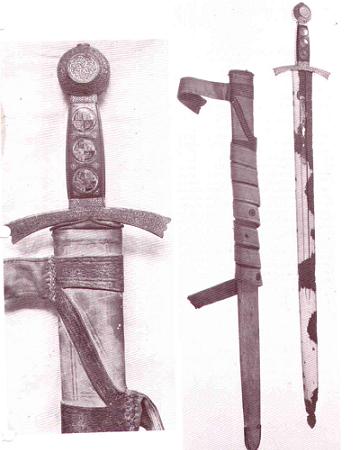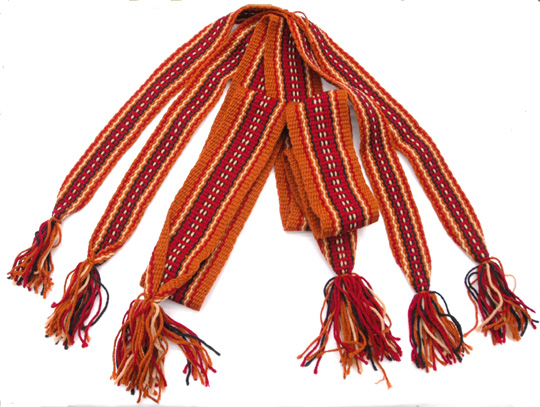| Author |
Message |
Sean Flynt

|
 Posted: Thu 16 Jul, 2009 1:16 pm Post subject: "Galloon" Sword Belt of Sancho IV Posted: Thu 16 Jul, 2009 1:16 pm Post subject: "Galloon" Sword Belt of Sancho IV |
 |
|
One of the late 13th c. tomb swords in ROTMS (sword of Sancho IV of Castille) has a scabbard with an interesting and relatively simple suspension. The scabbard attachment consists of two broad bands of leather joined by a separate, diagonal band of leather that keeps the other bands separated. The textile belt is attached to the bands by coarse stitching. There appears to be a small slit in the scabbard covering near the edge of the lower band, but the photo isn't clear. This appears to be a much simpler suspension than the complex arrangement of split belts and slits in the scabbard covering I tend to associate with scabbards of the period. I might try this with my Type XIV project, but I don't know where to find a textile belt.
The belt is described as "galloon," which is a woven, patterned material. Does anybody know of a modern equivalent suitable for this application? In theory, I suppose one could approximate the Sancho IV belt by making a long tube of heavyweight linen or cotton, pressing it flat and applying silk ribbon edging. It would be better, obviously, to have a purpose-made fabric belt of usual construction. Maybe a 2" wide cotton web belt? What about an appropriate buckle and strap end for this type of belt?
 Attachment: 21.51 KB Attachment: 21.51 KB

-Sean
Author of the Little Hammer novel
https://www.amazon.com/Little-Hammer-Sean-Flynt/dp/B08XN7HZ82/ref=sr_1_1?dchild=1&keywords=little+hammer+book&qid=1627482034&sr=8-1
|
|
   |
 |
|
Boyd C-F
Location: Nelson, New Zealand Joined: 08 Oct 2008
Posts: 57
|
 Posted: Thu 16 Jul, 2009 11:02 pm Post subject: Posted: Thu 16 Jul, 2009 11:02 pm Post subject: |
 |
|
Hiya
It looks like a nice simple scabbard hanger design. I suspect that the textile belt would have been "tablet woven". A process for making woven strips, strap, belts and edges.
If you know anyone into living history or the SCA they may be able to make one for you and you may even be able to choose the pattern and the colours.
Cheers
Boyd
|
|
  |
 |
Sean Flynt

|
 Posted: Fri 17 Jul, 2009 6:42 am Post subject: Posted: Fri 17 Jul, 2009 6:42 am Post subject: |
 |
|
| Boyd C-F wrote: | Hiya
It looks like a nice simple scabbard hanger design. I suspect that the textile belt would have been "tablet woven". A process for making woven strips, strap, belts and edges.
If you know anyone into living history or the SCA they may be able to make one for you and you may even be able to choose the pattern and the colours.
Cheers
Boyd |
Thanks, Boyd! I vaguely recall that there was something like that in the Indian trade goods of this country in the 18th c.--some kind of sash....
Yeah, this is what I remembered. These are 3.5" wide and 7' long, in different colors. Not cheap, at $43, and probably not available in solid colors or undyed.
 Attachment: 117.19 KB Attachment: 117.19 KB

-Sean
Author of the Little Hammer novel
https://www.amazon.com/Little-Hammer-Sean-Flynt/dp/B08XN7HZ82/ref=sr_1_1?dchild=1&keywords=little+hammer+book&qid=1627482034&sr=8-1
|
|
   |
 |
Jessica Finley
Industry Professional

Location: Topeka, Kansas Joined: 29 Dec 2003
Posts: 110
|
|
     |
 |
Sean Flynt

|
|
   |
 |
|
Boyd C-F
Location: Nelson, New Zealand Joined: 08 Oct 2008
Posts: 57
|
 Posted: Fri 17 Jul, 2009 1:52 pm Post subject: Posted: Fri 17 Jul, 2009 1:52 pm Post subject: |
 |
|
Even easier...
http://www.youtube.com/watch?v=C-VImNBJvA0
and you can take it anywhere, work, on the train, on a date...
Or you can get an inkle loom
http://www.youtube.com/watch?v=Ex2gmUDmZAY
You make textile belts for all of us!! 
Try a craft fair or something similar - you may find all the hard work is done for you and at a reasonable price.
If you do decide to go down the track of making it yourself, head towards a craft/wool/spinning shop run by elderly ladies, they are more than happy to set you off in the right direction and will give you a vast amount of information, but you may have to drink copious amounts of tea!
|
|
  |
 |
|
GG Osborne
|
 Posted: Fri 17 Jul, 2009 2:18 pm Post subject: Gallooning Posted: Fri 17 Jul, 2009 2:18 pm Post subject: Gallooning |
 |
|
Sean....
Gallooning refers to metallic gold braid, perhaps, but not often in my experience, silver. It is the ornamental braid added to either leather or perhaps velvet baldrics, sword belts, hats, gloves, uniforms. It is sometimes scalloped, twisted, or straight with a woven design. Check out the website for Hand and Co. in London. They have been in business since the 18th C. and are suppliers of many kinds of galloon used today by the UK military and have many styles.
Hope this helps.
Glenn
"Those who live by the sword...will usually die with a huge, unpaid credit card balance!"
|
|
  |
 |
|
Boyd C-F
Location: Nelson, New Zealand Joined: 08 Oct 2008
Posts: 57
|
|
  |
 |
Sean Flynt

|
|
   |
 |
|
Russ Ellis
Industry Professional
|
 Posted: Mon 20 Jul, 2009 1:23 pm Post subject: Re: Gallooning Posted: Mon 20 Jul, 2009 1:23 pm Post subject: Re: Gallooning |
 |
|
| GG Osborne wrote: | Sean....
Gallooning refers to metallic gold braid, perhaps, but not often in my experience, silver. It is the ornamental braid added to either leather or perhaps velvet baldrics, sword belts, hats, gloves, uniforms. It is sometimes scalloped, twisted, or straight with a woven design. Check out the website for Hand and Co. in London. They have been in business since the 18th C. and are suppliers of many kinds of galloon used today by the UK military and have many styles.
Hope this helps.
Glenn |
Thanks for that bit. After Sean's initial post I went back and took a look at my copy of Records (it's been far too long) and it seemed to me that the belt appeared to be leather but as you say with a decorative woven braid along the top edge, I need to read that description again...
Thanks as always for getting me thinking Sean.
TRITONWORKS Custom Scabbards
|
|
  |
 |
Sean Flynt

|
 Posted: Mon 20 Jul, 2009 1:41 pm Post subject: Re: Gallooning Posted: Mon 20 Jul, 2009 1:41 pm Post subject: Re: Gallooning |
 |
|
| Russ Ellis wrote: | | After Sean's initial post I went back and took a look at my copy of Records (it's been far too long) and it seemed to me that the belt appeared to be leather but as you say with a decorative woven braid along the top edge, I need to read that description again... |
The belt itself is fabric, with a silk border, as described in an article by David Nicolle ( http://gladius.revistas.csic.es/index.php/gla...view/59/60 ):
A preference for baldrics over sword-belts seems to have remained characteristic of medieval North Africa. The Marinid armies of 14th century Morocco, including the ruler's elite guards, still carried their swords in what was by then known as the ‘bedouin fashion’22. Within the Iberian peninsula pictorial sources show the baldric being used on both sides of the
religious frontier during the earlier medieval centuries. By the 13th century, however, Christian knights used sword-belts while squires used baldrics, clearly showing that the latter was regarded as a less prestigious way of carrying a sword23.
Nevertheless some Arab-Andalusian fashions survived this change, including the use of sword-belts made of highly decorated fabric rather than leather, which was almost universally used elsewhere in Western Europe. Amongst surviving examples of such a fabric sword-belts is that of the sword of Sancho IV of Castile now in the Capilla Mayor of Toledo Cathedral. Here the scabbard is attached to the belt by leather lockets while the belt itself is
of light green galloon (a narrow close-woven braid) with a red silk border.
Tablet weaving would seem to be the way to go. Also, it seems that a fabric belt identifies a sword as Spanish and of this period (1250-1300). That last fact might turn me away from this project because I was thinking more French. Still, I'm glad to have this very interesting information.
-Sean
Author of the Little Hammer novel
https://www.amazon.com/Little-Hammer-Sean-Flynt/dp/B08XN7HZ82/ref=sr_1_1?dchild=1&keywords=little+hammer+book&qid=1627482034&sr=8-1
|
|
   |
 |
|
GG Osborne
|
 Posted: Mon 20 Jul, 2009 2:42 pm Post subject: Posted: Mon 20 Jul, 2009 2:42 pm Post subject: |
 |
|
Part of the problem with the term "lace" in 18th C. parlance is that it refers to any decorative edging. The woven wool around the buttonholes of a soldier's uniform were referred to as "lace." Velvet trim around a hat brim was "lace." Gallooning, on the other hand, seems to have been used exclusively for metallic trim that we would call "braid" today.
"Those who live by the sword...will usually die with a huge, unpaid credit card balance!"
|
|
  |
 |
Glen A Cleeton

|
 Posted: Mon 20 Jul, 2009 5:28 pm Post subject: Posted: Mon 20 Jul, 2009 5:28 pm Post subject: |
 |
|
This 1920 quarterly from the Brooklyn Museum might be worth paging through in the 150 to 170 range,
http://books.google.com/books?id=eWMYAAAAYAAJ
I know I have it bookmarked and may never pull it off to the shelf to look again but there is an overview of textiles from ancient to post renaissance.
Cheers
GC
|
|
  |
 |
Sean Flynt

|
 Posted: Tue 21 Jul, 2009 7:06 am Post subject: Posted: Tue 21 Jul, 2009 7:06 am Post subject: |
 |
|
| Glen A Cleeton wrote: | This 1920 quarterly from the Brooklyn Museum might be worth paging through in the 150 to 170 range,
http://books.google.com/books?id=eWMYAAAAYAAJ
I know I have it bookmarked and may never pull it off to the shelf to look again but there is an overview of textiles from ancient to post renaissance.
Cheers
GC |
That's helpful (see p. 158). It seems to me that there are two meanings of "galloon." The earlier meaning appears to be as described by Nicolle. The modern meaning (probably since the 19th c., at least) appears to indicate the metallic braid discussed above.There is some overlap in meaning, with galloon fabric sometimes containing metallic threads, and that's probably the origin of the modern usage. The belt of the Sancho IV sword is light green, and there's no mention of metallic elements. That suggests to me that it's all fabric.
-Sean
Author of the Little Hammer novel
https://www.amazon.com/Little-Hammer-Sean-Flynt/dp/B08XN7HZ82/ref=sr_1_1?dchild=1&keywords=little+hammer+book&qid=1627482034&sr=8-1
|
|
   |
 |
|
GG Osborne
|
 Posted: Tue 21 Jul, 2009 4:01 pm Post subject: Posted: Tue 21 Jul, 2009 4:01 pm Post subject: |
 |
|
Sean....
I know the term "galloon" referring to metallic braid goes back to at least the 16th century and possibly earlier.
"Those who live by the sword...will usually die with a huge, unpaid credit card balance!"
|
|
  |
 |
Glen A Cleeton

|
 Posted: Tue 21 Jul, 2009 4:51 pm Post subject: Posted: Tue 21 Jul, 2009 4:51 pm Post subject: |
 |
|
| GG Osborne wrote: | Sean....
I know the term "galloon" referring to metallic braid goes back to at least the 16th century and possibly earlier. |
Yet, it would appear that the word (and origin) is not just meant as such metallic properties of weaving or surface treatments in such textiles.
Cheers
GC
|
|
  |
 |
|
|

